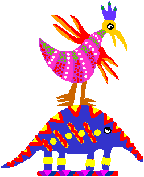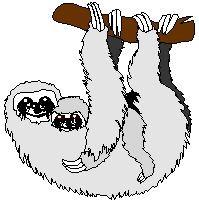
What can a sloth teach me about life?

The incredible sloth
The sloth, when placed on the ground, seems strangely and awkwardly formed. His fore legs, or, more correctly speaking, his arms, seem at first to be much too long, while his hind legs are very short and look bent, so that when put on the ground, his belly touches it. He cannot walk. He can only drag himself slowly on the ground.
Suppose, then, he supported himself on his legs, like other animals, he would be in pain, for he has no soles on his feet, and his claws are very sharp and long and curved, so that if his body were supported on his feet, it would be by their extremities—just as your body would be, if you were to throw yourself on all fours, and try to support your weight on the ends of your toes and fingers!
If the floor were made of glass, or of a polished surface, the sloth would have trouble moving at all, but since the ground is generally rough, with stones, roots of grass, etc., it suits the sloth well. He moves his fore legs in all directions, in order to find something to hold on to.
When he has succeeded, he pulls himself forward, and so is able to travel onward, but at the same time in such a slow and awkward a manner that he was given the name of sloth. His looks and gestures, and his sighs every now and then, make it clear that he is uncomfortable on the ground and maybe even in pain.
His limbs are designed for hanging and grasping, not for supporting his weight on the ground.
In the wild, the sloth spends almost his whole life in trees.
If he needs to cross, a river or lake, you will see that the sloth is a good, strong swimmer—able to reach speeds of 40 feet per minute (13 meters). He is also able to hold his breath underwater for up to 40 minutes.
God made man and women to walk on the surface of the Earth, the eagle to soar in the expanse of the skies, and the monkey and squirrel to inhabit the trees. Still these may change their normal situations without feeling much inconvenience, but the sloth must spend almost his whole life in the trees.

Amazingly sloths do not spend much time on top of the branches, like a squirrel or a monkey. Sloths hang upside down underneath branches 80% of their life.
When asleep, he supports himself from a branch parallel to the ground. He first seizes the branch, with his special hands and feet, with their long, curved claws. He is then able to comfortably hang under a sheltering branch. In this position he is perfectly at rest—with no effort.
Now, if he had a tail, he would be at a loss to know what to do with it? If he raised it up between his legs, it would interfere with them. If he let the tail hang down, it would blow about in the winds. God provided the sloth with the advantage a stubby, short tail.
A surprising encounter with a sloth
One day, a man in the forest found a large two-toed sloth on the ground on the bank of a river. “As soon as I got up to him,” he said, “the sloth threw himself upon his back, and defended himself in gallant style with his fore legs.”
“Come, poor fellow,” the man said, “I won’t take no advantage of you in your misfortune; the forest is large enough for both you and me to roam in. Go your ways up above, and enjoy yourself in these endless wilds; you may never see another man, so fare thee well.”
On saying this, the man took a long stick which was lying there, held it for the sloth to hook on, and then raised him to a high and stately tree. The sloth quickly climbed up, and in about a minute he was almost at the top.
Some people have misjudged the sloth, from descriptions given of him creeping uncomfortably on the ground, and not in his normal position—clinging to the branch of a tree.
What can you learn from this?
We must be careful not to quickly judge others. People should be appreciated for those things which they do BEST. We must remember that people have DIFFERENT abilities, experiences and education. A weaver might make a poor blacksmith; a carpenter might make a poor tailor; and yet each of them in their own workplace may do his work very well. No one should be blamed for lacking something he never had an opportunity to get.
Learn more
- Discover the amazing TARSIER

 More RAINFOREST ANIMALS
More RAINFOREST ANIMALS Learn about the rainforest by meeting some native peoples, seeing where and how they live, and more! A cross-cultural photo-rich journey that will leave you with a lasting impression.
Learn about the rainforest by meeting some native peoples, seeing where and how they live, and more! A cross-cultural photo-rich journey that will leave you with a lasting impression. ANIMALS of the Bible
ANIMALS of the Bible
